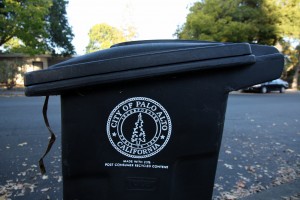
Some residents of single-family homes in Palo Alto will soon be able to compost food scraps in a bid to divert thousands of tons of waste from the landfill. The City Council is evaluating plans for pilot projects that would collect organic materials from green bins and reduce or eliminate regular garbage pickup.
City officials want to hear from residents before choosing local neighborhoods to begin a yearlong trial of the program in early 2013.
The Department of Public Works made the proposals after a recent study revealed that three quarters of the waste in Palo Alto garbage carts was not garbage. Most was either compostable or recyclable material.
“We want to get food scraps out of the landfill and do something productive with them,” Assistant Director of Public Works Phil Bobel said.
The city has collected compostable materials such as food scraps and milk cartons from businesses and apartment buildings since 2009. Bobel said that program massively reduced the volume of garbage. According to the department’s report, more than 10,000 tons of organic materials were diverted in the last year.
Until now, however, the Council could not identify an affordable way to make this same service available to single-family homes. Residents were left with a choice between composting at home or sending their food scraps to the landfill.
Bobel and Ron Arp, acting manager of the solid waste program, pitched their pilot proposals to the City Council’s finance committee Tuesday night.
In one proposed pilot option, residents would place organic wastes in their green carts with their yard trimmings. Garbage would be collected biweekly or bimonthly and would only include non-compostable and non-recyclable items.
The alternative pilot option eliminates garbage pickup entirely by using a system called Wet-Dry Collection. Organic products would go in green carts, but all solid and recyclable wastes would go in blue recycling carts. Residual garbage would then be removed from the recyclables at the GreenWaste Material Recovery Facility.
In either case, “putrescible wastes,” or self-decomposing items such as diapers, food scraps and pet feces, would be collected weekly through the green bins in accordance with state health and sanitation regulations.
“People worry when they hear that garbage collection may be eliminated or reduced, but the stinky things will be gone,” Arp said. “They’re just being transferred to different bins.” The council emphasized the need to keep this aspect of the pilot clear to avoid misguided agitation.
“In San Francisco, you have many apartments and few yard clippings, so it’s cost effective to collect food scraps there,” said Council member Nancy Shepherd, who chairs the finance committee. “Here, it’s harder.”
Shepherd said the council wanted to make progress on Palo Alto’s Zero Waste Operation Plan without increasing collection fees and hoped that one of these pilot programs would offer an affordable solution.
According to Bobel, a reduction in garbage pickup could make up for the costs of composting or even save the city money. If Palo Alto eliminates one of its three types of trucks that are in weekly circulation, the city could also cut down on traffic and noise pollution.
While council members liked the simplicity of a two-bin system, some residents worried that mixing garbage with recyclables could reduce the level of thought locals put into their environmental footprints. “Composting is consciousness-raising,” said Michael Closson, executive director of the environmental nonprofit Acterra. “With single-stream programs, you lose that. I’m enough of a cynic to believe that each one of us has to take personal steps to improve.”
Closson nonetheless stressed the benefits of residential composting and hoped it would reduce the contamination of recycled materials.
Pilot leaders say they will meet with neighborhood associations in the near future. If the project goes ahead, hundreds of households will participate.
After a yearlong trial, Arp said, the council will evaluate the project to see if it is suitable for the rest of the city — looking at the program’s cost, impact on garbage volume, effect on street congestion and greenhouse gases, and ability to meet community needs.
Arp is hopeful that the pilot will reflect a feasible way to divert some of the 5,800 tons of compostable material that ends up in the landfill every year.
“We haven’t reached Zero Waste, but this is a key step,” Bobel concluded.
